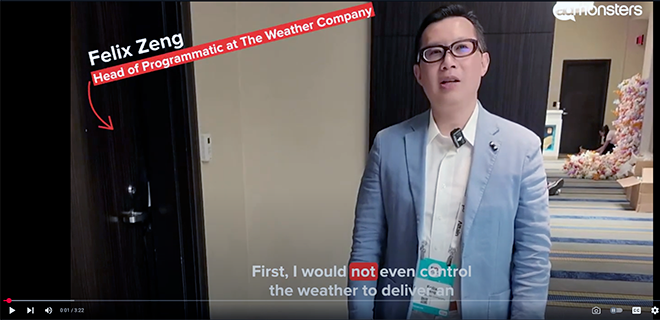
At POSSIBLE 2025, we caught up with Felix Zeng, Head of Programmatic at The Weather Company, to discuss data ethics, environmental signals, and how forecasting weather and ad trends aren’t all that different—until they are.
When you work in programmatic for a company built on forecasting weather, people assume you can see the signals before anyone else. That’s whether it’s a storm or a shift in programmatic strategy. So we asked Felix Zeng, Head of Programmatic at The Weather Company, what today’s environmental signals tell us about the future of advertising.
Putting Users First—Even When the Data Performs
When we asked what weather he’d create to guarantee an ad campaign’s success, he said, “I would not control the weather to deliver an advertiser’s forecast. We’re always user-first.”
The Weather Company gives advertisers tools to activate against real-time and forecasted conditions, targeting ads using environmental triggers like pollen or thunderstorms. Weather-triggered marketing is a proven performance strategy, especially for pharma, CPG, and retail categories. These ecological signals can all be used to drive engagement.
While that kind of high-quality data could boost performance, Zeng’s response focuses on prioritizing users and using data ethically.
“Weather affects allergies. And I wouldn’t want to enlarge the area where people get severe allergies. Our goal is to inform users when there is an area where extreme allergies can happen and also let them plan a day when there are emergencies,” he said.
▶️ Watch the full interview below, then scroll for more highlights from our conversation.
Weather Signals = Underused Strategy
Real-world weather cues drive meaningful outcomes for brands. Consider a flu medication brand displaying an ad when there’s a cold front or increased humidity, a beverage brand activating cold drink ads when temperatures hit 85°F+, or even a skincare brand running UV-related ads on sunny days.
These environmental signals might be full-funnel gold, but all too often, brands are still sleeping on them.
“We have clients that go back 20 years,” Zeng said, “but we’re still just scratching the surface of what this data can do for marketers.”
A Forecast for Google? Cloudy, But Hopeful
With Google’s antitrust case and post-cookie plans still in flux, we asked Zeng to share his weather forecast for the current climate. “Cloudy, with a slight chance of sunshine,” he responded.
The sunshine, in his view, is industry-wide collaboration. “It’s not going to be immediate, and yes, Google will appeal. But I’m optimistic we’ll come together to find a solution that works for everyone.”
The Vibe in the Industry Is Resilience
While the industry has experienced its fair share of pressure—economic uncertainty, shifting regulation, rising expectations—Zeng said the most refreshing part of being on the ground at POSSIBLE was hearing how many people are still focused on solutions.
“It’s great to talk to people and still look at what we can solve together, despite what’s happening outside,” he said.
Can You Predict Ad Trends Like You Predict the Weather?
Not quite. “You can predict the weather in the next hour,” he said. “Ad trends? That’s another story.”
Still, when clients are deciding whether to take a boat out in the middle of a storm—yes, that happened—the programmatic leader calls in the experts. Thanks to a heads-up from his meteorologist colleagues, he told a room full of clients to wait one hour. The storm cleared. He looked like a hero.
The lesson? Know your data. Know your signals. Know your sources.
And maybe—just maybe—don’t try to control the weather.